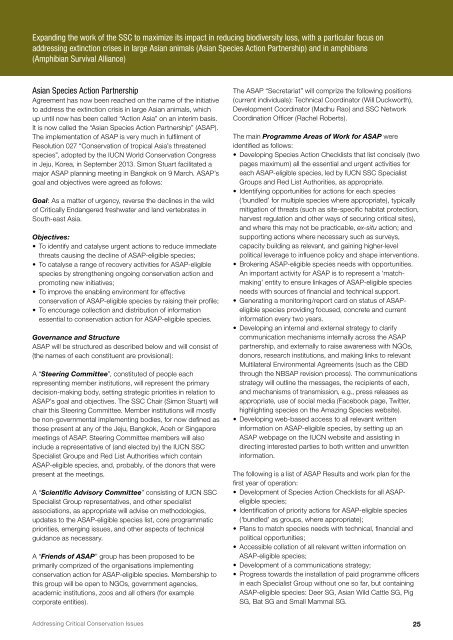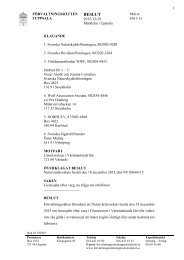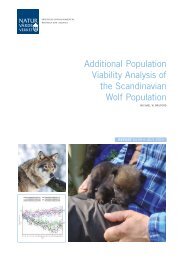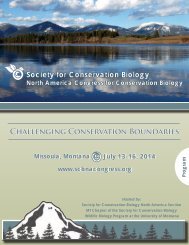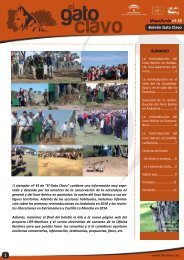1oC3Dbk
1oC3Dbk
1oC3Dbk
Create successful ePaper yourself
Turn your PDF publications into a flip-book with our unique Google optimized e-Paper software.
Expanding the work of the SSC to maximize its impact in reducing biodiversity loss, with a particular focus on<br />
addressing extinction crises in large Asian animals (Asian Species Action Partnership) and in amphibians<br />
(Amphibian Survival Alliance)<br />
Asian Species Action Partnership<br />
Agreement has now been reached on the name of the initiative<br />
to address the extinction crisis in large Asian animals, which<br />
up until now has been called “Action Asia” on an interim basis.<br />
It is now called the “Asian Species Action Partnership” (ASAP).<br />
The implementation of ASAP is very much in fulfilment of<br />
Resolution 027 “Conservation of tropical Asia’s threatened<br />
species”, adopted by the IUCN World Conservation Congress<br />
in Jeju, Korea, in September 2013. Simon Stuart facilitated a<br />
major ASAP planning meeting in Bangkok on 9 March. ASAP’s<br />
goal and objectives were agreed as follows:<br />
Goal: As a matter of urgency, reverse the declines in the wild<br />
of Critically Endangered freshwater and land vertebrates in<br />
South-east Asia.<br />
Objectives:<br />
• To identify and catalyse urgent actions to reduce immediate<br />
threats causing the decline of ASAP-eligible species;<br />
• To catalyse a range of recovery activities for ASAP-eligible<br />
species by strengthening ongoing conservation action and<br />
promoting new initiatives;<br />
• To improve the enabling environment for effective<br />
conservation of ASAP-eligible species by raising their profile;<br />
• To encourage collection and distribution of information<br />
essential to conservation action for ASAP-eligible species.<br />
Governance and Structure<br />
ASAP will be structured as described below and will consist of<br />
(the names of each constituent are provisional):<br />
A “Steering Committee”, constituted of people each<br />
representing member institutions, will represent the primary<br />
decision-making body, setting strategic priorities in relation to<br />
ASAP’s goal and objectives. The SSC Chair (Simon Stuart) will<br />
chair this Steering Committee. Member institutions will mostly<br />
be non-governmental implementing bodies, for now defined as<br />
those present at any of the Jeju, Bangkok, Aceh or Singapore<br />
meetings of ASAP. Steering Committee members will also<br />
include a representative of (and elected by) the IUCN SSC<br />
Specialist Groups and Red List Authorities which contain<br />
ASAP-eligible species, and, probably, of the donors that were<br />
present at the meetings.<br />
A “Scientific Advisory Committee” consisting of IUCN SSC<br />
Specialist Group representatives, and other specialist<br />
associations, as appropriate will advise on methodologies,<br />
updates to the ASAP-eligible species list, core programmatic<br />
priorities, emerging issues, and other aspects of technical<br />
guidance as necessary.<br />
A “Friends of ASAP” group has been proposed to be<br />
primarily comprized of the organisations implementing<br />
conservation action for ASAP-eligible species. Membership to<br />
this group will be open to NGOs, government agencies,<br />
academic institutions, zoos and all others (for example<br />
corporate entities).<br />
The ASAP “Secretariat” will comprize the following positions<br />
(current individuals): Technical Coordinator (Will Duckworth),<br />
Development Coordinator (Madhu Rao) and SSC Network<br />
Coordination Officer (Rachel Roberts).<br />
The main Programme Areas of Work for ASAP were<br />
identified as follows:<br />
• Developing Species Action Checklists that list concisely (two<br />
pages maximum) all the essential and urgent activities for<br />
each ASAP-eligible species, led by IUCN SSC Specialist<br />
Groups and Red List Authorities, as appropriate.<br />
• Identifying opportunities for actions for each species<br />
(‘bundled’ for multiple species where appropriate), typically<br />
mitigation of threats (such as site-specific habitat protection,<br />
harvest regulation and other ways of securing critical sites),<br />
and where this may not be practicable, ex-situ action; and<br />
supporting actions where necessary such as surveys,<br />
capacity building as relevant, and gaining higher-level<br />
political leverage to influence policy and shape interventions.<br />
• Brokering ASAP-eligible species needs with opportunities.<br />
An important activity for ASAP is to represent a ‘matchmaking’<br />
entity to ensure linkages of ASAP-eligible species<br />
needs with sources of financial and technical support.<br />
• Generating a monitoring/report card on status of ASAPeligible<br />
species providing focused, concrete and current<br />
information every two years.<br />
• Developing an internal and external strategy to clarify<br />
communication mechanisms internally across the ASAP<br />
partnership, and externally to raise awareness with NGOs,<br />
donors, research institutions, and making links to relevant<br />
Multilateral Environmental Agreements (such as the CBD<br />
through the NBSAP revision process). The communications<br />
strategy will outline the messages, the recipients of each,<br />
and mechanisms of transmission, e.g., press releases as<br />
appropriate, use of social media (Facebook page, Twitter,<br />
highlighting species on the Amazing Species website).<br />
• Developing web-based access to all relevant written<br />
information on ASAP-eligible species, by setting up an<br />
ASAP webpage on the IUCN website and assisting in<br />
directing interested parties to both written and unwritten<br />
information.<br />
The following is a list of ASAP Results and work plan for the<br />
first year of operation:<br />
• Development of Species Action Checklists for all ASAPeligible<br />
species;<br />
• Identification of priority actions for ASAP-eligible species<br />
(‘bundled’ as groups, where appropriate);<br />
• Plans to match species needs with technical, financial and<br />
political opportunities;<br />
• Accessible collation of all relevant written information on<br />
ASAP-eligible species;<br />
• Development of a communications strategy;<br />
• Progress towards the installation of paid programme officers<br />
in each Specialist Group without one so far, but containing<br />
ASAP-eligible species: Deer SG, Asian Wild Cattle SG, Pig<br />
SG, Bat SG and Small Mammal SG.<br />
Addressing Critical Conservation Issues<br />
25


